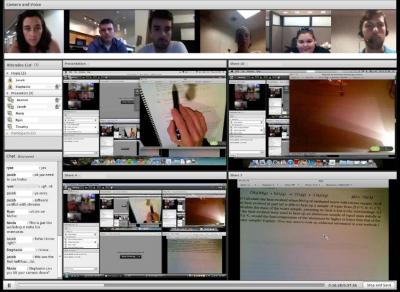CLOUD
IUPUI researchers evaluate peer-led team learning in cyberspace

Peer-Led Team Learning in undergraduate education is growing in popularity in universities across the country in courses in science, technology, engineering and mathematics – known collectively as the STEM disciplines. New research by faculty and students from the School of Science and the Center for Teaching and Learning at Indiana University-Purdue University Indianapolis evaluates peer-led team learning for STEM focusing on its newest iteration – cyber peer-led team learning.
Peer-Led Team Learning, known as PLTL, is an innovative model of undergraduate instruction that augments the traditional lecture with a weekly two-hour workshop in which six to eight students work together to solve challenging problems under the guidance of a peer leader. The peer leader is a fellow undergraduate who has mastered the material and is a good communicator. In addition to course content instruction, he or she receives training in teaching methods such as how to work with students who attempt to dominate sessions and how to provide a boost to students who have difficulty participating. In addition to face-to-face PLTL, IUPUI has developed an online version know as cPLTL.
Pratibha Varma-Nelson, Ph.D., professor of chemistry and chemical biology at the School of Science and executive director of IUPUI's Center for Teaching and Learning, has been involved in the development and implementation of PLTL since 1995. She is the co-author of "PLTL: Tracking the Trajectory from Face-to-Face to Online Environments," a chapter in the newly published American Chemical Society volume Trajectories of Chemistry Education Innovation and Reform, of which Varma-Nelson is a co-editor.
"General chemistry and other introductory science and engineering courses at most universities are lecture courses with hundreds of students. We know that students learn by doing things themselves and with PLTL, with expert learners teaching their peers, students get 10 to 15 percent better grades than when peer-led teaching sessions are not part of the curriculum," Varma-Nelson said.
"Faculty and students should work as partners in constructing learning environments. PLTL is an example of such a partnership where peer leaders partner with faculty to facilitate the learning of students that are slightly less advanced than themselves and they also advice faculty on what is working or not working in the course. cPLTL further exemplifies this partnership with the peer leaders taking the lead in developing the cyber environment for conducting PLTL workshops. We are currently conducting a study comparing grades, demographics, behavior and other characteristics of students in both face-to-face PLTL and cPLTL to learn more about how undergraduates learn in the two environments," Varma-Nelson said.
A recent study in the online journal Educause Review, "Supporting Student Collaboration in Cyberspace: A cPLTL Study of Web Conferencing Platforms," by Varma-Nelson and IUPUI colleagues, including undergraduates, evaluates available technology platforms meeting the audio and video networking needs of cPLTL. The researchers found that a commercial product (Adobe Connect) and an open source product (Google Hangout) offer the most essential additional features such as chat box and shareware function as well as easy online usability. Unlike the commercial program, the free program does not, however, record the workshops. Recorded sessions enable faculty to evaluate peer-leaders and help them improve their performance as well as providing vital information for researchers on how students learn and work together.
Stephanie Metcalf, one of the new study's lead authors, is a senior chemistry major in the School of Science and a cPLTL peer leader for the School's general chemistry course. She has found that both students and peer leaders like the virtual environment. It's not only that the students can be in their pajamas during the problem solving sessions, it's that cyber workshops are easier to fit into their busy schedules -- many students work or have family responsibilities. Plus students feel comfortable working online, Metcalf explained.
Metcalf, president of the Science Ambassador Leadership Team working to help attract high school students to science, says that being a PLTL peer leader has given her a real interest in college teaching. She is currently in the process of applying to doctoral programs in biomedical sciences.
"We expect that, like Stephanie, many of the students who are participating in or leading PLTL and cPLTL workshops today will aim for a STEM related profession. But whatever their chosen career path, it is highly likely that they will be working in groups or teams – something that PLTL really teaches them how to do," Varma-Nelson said.

